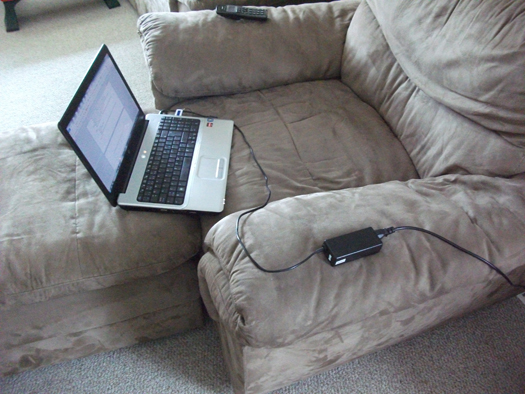Why You Should Self-publish Part Two
(from Getting Down and Digital: How to Self-publish Your Book)
By taking on the role of a publisher, the one who fronts the cost to turn a manuscript into a published book, the self-publisher takes all the risk—but also reaps all the reward as a result. Think of it as an investment. Folks go to the bank all the time and dump in fifty dollars, a hundred dollars, a thousand or more into RRSPs or GICs, money they’ll never touch for years, but while it’s sitting there, it’ll earn them much more than they originally invested given enough time. Self-publishing is the same way. Even if your up-front costs are a thousand dollars, you start selling your books and, depending on format, make $3-10 profit, once you’ve sold 100-333 copies, you’ve made your money back. Everything above that is your return on your investment. And instead of making a dollar or even two dollars a book sold as per the traditional royalty system with the rest going to your publisher—and to be fair, they deserve to make money for bringing the book to market for you and taking care of you during your contract with them—you get to keep all the profits for yourself.
There’s huge potential to make a lot of money self-publishing. Like I said, if you set up your system to ensure you make $3-10 profit per book (i.e. $3 minimum on an eBook sale and $10 or so on the high end for a paperback sale), you could come away with a very secure future assuming the market is kind to you. To sell 50 eBooks would pay my water bill for three months. I could do the same if I sold 15 paperbacks at a convention as I average around $10 profit per sale through those direct-to-reader venues.
Before, a writer would have to sell thousands of copies of their book just to stay afloat because they made anywhere from 80 cents to a couple bucks a book depending on format. Sometimes less. And while it’s great that they sold those thousands of copies so they could pay their bills, imagine how much more they could’ve made had they been able to do the same volume of sales on their own? If they sold 2000 books total and made the aforementioned 80 cents to two dollars, that would be around $1600-4000 in their pocket. If they self-published and averaged $3-10 per sale, that’s a range of $6000-20,000 to their credit. A huge, huge difference, and for some, enough of a difference between having a bed to sleep in and food on the table.
The beauty of self-publishing is the ability to produce a book for a niche market, something that you don’t typically find in the mainstream, if at all. For example, I write superhero fiction. Back when I started doing it in 2006, my series, The Axiom-man Saga, was one of a handful of other independent superhero fiction books. There was no way I could take my manuscript and sell it to a publishing house because no one would take the risk on a completely unknown superhero with no proven track record. Well, guess what? By self-publishing the series, I’ve been able to find an audience for it and every time a new installment in The Axiom-man Saga comes out for a convention or on-line, people buy copies. And when I’m behind on getting a new book out because I’m committed to other projects, people start asking me when the next book in The Axiom-man Saga is coming out.
Self-publishing is also great for those who can’t keep their hands to themselves. Some writers need to be involved with their book every step of the way, and while this goes back to self-publishing enabling the writer complete control of the project, it also lends itself to writers who are also entrepreneurs, who are business people by nature.
There are two types of people in the world: those who take risks and those who don’t. Entrepreneurs are risk-takers. They see the potential for a business and are willing to spend the money—sometimes money they don’t have—to make it happen even though there’s the possibility it might not work out. And that’s their mindset when it comes to self-publishing: it’s a business. And what do businesses do? They manufacture a product and market it to people. Even service-providing businesses do the same because a service is a product. The entrepreneurial self-publisher is someone who isn’t just a creative individual, but also one with a business-oriented mindset, someone who has a vision for their book beyond simply writing it and are willing to take the risk(s) involved to make that vision a reality. While I personally don’t view books as “products” but works of art, from the outside looking in that’s what a publisher does: sells a product.
The other advantage to self-publishing is to take a book and prove to a traditional publisher there is a market for it. There are many stories of writers self-publishing rejected manuscripts—which weren’t necessarily rejected for quality reasons—and turning them into bestsellers. There are also those who have self-published, had major success, and then were picked up by a traditional publisher who took on the publishing duties of the same book. Often, these publishers paid a lot of money to have these books in their catalog because the writer showed them there’s an audience for their book(s) out there. You need to sell several thousand copies to catch a traditional publisher’s interest, something to the tune of 5000 copies-plus, but self-publishing is an excellent way to give a chance at life to a book that otherwise would’ve been sitting in a rejection pile somewhere.
By self-publishing, you are also the sole rights holder to the book. And while true even if you sold the book to a traditional publisher you’d still be the sole author and copyright holder, the traditional publisher would be the one who holds the print and electronic rights to it, meaning they could be the only ones to publish the book in the language they represent. Depending, some traditional publishers take additional rights when taking on a book: audio, film, even foreign translation rights if they are connected in that way. The first two are the most common. By going it alone, you decide who gets what, so if some guy from Hollywood wants to make a movie out of your book, you don’t need to share the monies offered with anyone if you negotiate the deal yourself. You’d also get to decide how much influence you’ll have on the movie, though, of course, if you want too much influence—and how much influence is “too much” is up to Joe Hollywood—then the deal might not happen at all. Regardless, to be the one in charge of deciding what other ways people can experience your story is up to you if you self-publish.
If you’re a salesman or are good with people, then the marketing of self-publishing should excite you. For some, sales are a thrill-of-the-chase thing and for every sale they land, they get a high off it. And to know that for every hour of effort you put into selling your book will reap you and you alone the financial reward of doing so should make you even more excited. Books usually don’t sell themselves, but if marketing and creating campaigns is an area of interest for you, self-publishing is an excellent field to do it in.
As you can see, there are numerous advantages to self-publishing your book, the main ones being control and the potential to make more money. You also get to bypass anyone who might reject publishing your book and just take it directly to the reader themselves and let them decide.
But most importantly, self-publishing is a ton of fun and I love every minute of it. Unless a traditional publisher comes along and can do something for me I can’t do on my own, then I plan on self-publishing for the remainder of my writing career.
Having too much of a blast doing so.
Maybe you will, too.




















